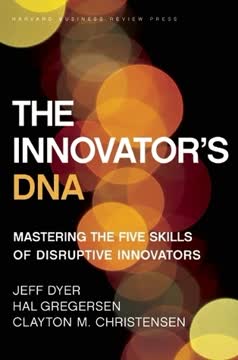Key Takeaways
1. Uncertainty demands a new management approach: The Innovator's Method
The key message in this book is that new tools and perspectives for validating big ideas characterized by high uncertainty are emerging in many disparate fields.
The Innovator's Method is a response to increasing uncertainty in business. Traditional management practices, designed for executing known business models, fail when facing the unknown. This method combines insights from lean startup, design thinking, and agile development to provide a systematic approach for innovation under uncertainty.
Key components of the Innovator's Method:
- Insight: Generate and capture innovative ideas
- Problem: Deeply understand customer needs
- Solution: Rapidly prototype and test solutions
- Business Model: Validate go-to-market strategy
Benefits of the Innovator's Method:
- Reduces risk of building products nobody wants
- Accelerates learning and innovation cycles
- Increases chances of success in uncertain environments
2. Identify customer problems through deep observation and experimentation
To deeply understand the job-to-be-done, don't count on traditional marketing studies, analyst reports, news articles, surveys, or even focus groups.
Customer empathy is crucial for identifying worthwhile problems to solve. The Innovator's Method emphasizes direct observation and experimentation to uncover customer needs, rather than relying on traditional market research methods.
Techniques for understanding customer problems:
- Ethnography: Observe customers in their natural environment
- Pain-storming: Map customer journeys and identify pain points
- "Advice" interviews: Ask customers for advice on solving their problems
Key questions to ask:
- What job is the customer trying to get done?
- What are the functional, social, and emotional dimensions of the job?
- What are the biggest pain points in the current process?
3. Develop solutions rapidly using prototypes and customer feedback
If you can increase the number of experiments you try from 100 to 1,000, you dramatically increase the innovations you produce.
Rapid prototyping is essential for testing and refining solutions quickly. The Innovator's Method advocates for creating multiple, low-fidelity prototypes to test key assumptions with customers before investing heavily in product development.
Types of prototypes:
- Theoretical prototype: Mental image of the solution
- Virtual prototype: Simple mock-up or simulation
- Minimum viable prototype (MVP): Basic working version
- Minimum awesome product (MAP): Delightful core experience
Benefits of rapid prototyping:
- Faster learning cycles
- Lower development costs
- Higher likelihood of finding product-market fit
4. Validate your business model before scaling
As you engage in the four behaviors, it's crucial to search broadly: look for ideas across countries, industries, companies, technologies, functions, and so on.
Business model validation is critical before investing heavily in scaling. The Innovator's Method emphasizes testing all aspects of the business model, including pricing, customer acquisition, and cost structure, through small-scale experiments.
Key components of business model validation:
- Value proposition: Test customer willingness to pay
- Customer acquisition: Experiment with marketing channels and messaging
- Cost structure: Validate key activities and resources needed
Tools for business model validation:
- Price sensitivity meter: Determine optimal pricing
- Consumption chain analysis: Understand customer decision-making process
- Customer influence pyramid: Identify key influencers in purchase decisions
5. Master the art of pivoting to refine your product and strategy
Pivots are an essential part of every stage of the innovator's method. You should expect to be wrong and focus instead on learning as quickly as possible and then changing when you discover that a guess was wrong.
Effective pivoting is crucial for refining your product and strategy based on customer feedback and market realities. The Innovator's Method encourages embracing change as a natural part of the innovation process.
Types of pivots:
- Problem pivot: Change the problem you're solving
- Solution pivot: Change how you solve the problem
- Business model pivot: Change how you capture value
Guidelines for effective pivoting:
- Set short pivot cycles (2-3 months) to create urgency
- Use multiple approaches to test assumptions (abductive, inductive, deductive)
- Look for "pivot takeoff" - significant changes in customer interest
6. Scale your innovation by transitioning from exploration to execution
As soon as you start to scale, everything is going to change. Everything.
Scaling requires a transition from entrepreneurial management to more traditional management practices. The Innovator's Method provides guidance on how to make this transition while maintaining innovation capabilities.
Key areas to focus on when scaling:
- Market scaling: Move from early adopters to mainstream customers
- Process scaling: Standardize and optimize key processes
- Team scaling: Build the right team with appropriate skills
Challenges in scaling:
- Balancing flexibility with standardization
- Maintaining innovation culture while increasing efficiency
- Adapting leadership style to growing organization
7. Adapt the Innovator's Method to your specific context and innovation type
The issue at stake is a matter of timing and perception. Early in the life of a disruptive innovation, it often appears "not good enough."
Contextual adaptation is crucial for successfully applying the Innovator's Method. The approach needs to be tailored based on your role, organizational context, and the type of innovation you're pursuing.
Adapting based on role:
- Individual contributor: Use "stealth mode" experimentation
- Team leader: Apply rapid prototyping and testing cycles
- Organization leader: Build innovation capabilities across the company
Adjusting for innovation type:
- Incremental innovation: Faster feedback cycles, existing resources
- Disruptive innovation: Longer timelines, separate organizational structures
Key considerations for adaptation:
- Organizational culture and support for innovation
- Available resources and constraints
- Industry-specific regulatory or technical requirements
Last updated:
FAQ
What's The Innovator's Method about?
- Focus on Innovation Management: The Innovator's Method by Nathan Furr provides a structured approach to managing innovation, especially in uncertain environments. It integrates lean start-up, design thinking, and agile development principles.
- End-to-End Process: The book outlines a step-by-step process for creating, refining, and launching ideas, emphasizing testing and validation before full-scale implementation.
- Real-World Examples: It includes case studies from companies like Intuit and Rent the Runway, demonstrating practical applications of the method for successful innovation.
Why should I read The Innovator's Method?
- Practical Framework: The book offers a practical framework for managers and entrepreneurs to foster innovation, equipping them with tools to navigate uncertainty effectively.
- Learn from Success Stories: By examining successful companies, readers gain insights into effective innovation practices and common pitfalls.
- Adaptable Methods: The strategies discussed are applicable to both start-ups and established companies, making it relevant for a wide audience facing innovation challenges.
What are the key takeaways of The Innovator's Method?
- Embrace Uncertainty: Uncertainty is a natural part of innovation and should be embraced. Managers are encouraged to become "chief experimenters."
- Iterative Testing: Rapid experimentation and iteration are crucial, using prototypes to test assumptions and validate ideas before committing resources.
- Customer Needs Focus: Understanding the "job-to-be-done" for customers is essential, ensuring innovations are relevant and valuable.
What is the "innovator's method" defined in The Innovator's Method?
- Four Key Steps: The method consists of Insight, Problem, Solution, and Business Model, each addressing specific uncertainties and validating ideas.
- Savor Surprises: Innovators are encouraged to "savor surprises" for valuable insights into customer needs and potential solutions.
- Prototyping and Validation: Emphasizes prototyping solutions and validating business models through customer feedback before scaling.
How does The Innovator's Method differ from traditional management?
- Focus on Uncertainty: Unlike traditional management, which emphasizes optimization, the method prioritizes learning and adaptation in uncertain environments.
- Iterative vs. Linear: The method is iterative, allowing continuous feedback and adjustments, contrasting with the linear approach of traditional management.
- Customer Engagement: It emphasizes direct customer engagement to understand needs, unlike traditional reliance on market research.
How does The Innovator's Method suggest overcoming barriers to innovation?
- Allocate Time for Innovation: Encourages allocating time for employees to engage in innovative activities, like unstructured time or hackathons.
- Remove Organizational Barriers: Leaders should create an environment that supports experimentation and reduces the fear of failure.
- Provide Tools and Resources: Companies should equip teams with necessary tools, customer access, and support for rapid experimentation and prototyping.
What is the significance of "prototyping" in The Innovator's Method?
- Rapid Learning: Prototyping is crucial for rapid learning and testing assumptions about customer needs and preferences.
- Types of Prototypes: The book outlines theoretical, virtual, minimum viable, and minimum awesome products, each serving different purposes.
- Avoiding Over-Engineering: Advocates for simplicity in prototypes, focusing on core features that matter most to customers.
What is a Minimum Awesome Product (MAP) according to The Innovator's Method?
- Definition of MAP: A MAP is a refined version of a minimum viable product that not only meets basic functionality but also delights customers.
- Customer Feedback: Development involves gathering customer feedback to enhance features and usability, ensuring the product resonates with users.
- Emotional Connection: A MAP should create an emotional connection with customers, leading to higher loyalty and advocacy.
How can I apply the Innovator's Method in my organization?
- Start Small: Assemble a small team to explore innovation opportunities, focusing on understanding customer problems.
- Encourage Experimentation: Foster a culture where team members feel safe to test ideas and learn from failures, using rapid prototyping.
- Engage Customers: Actively involve customers in the innovation process to gather insights and feedback, aligning solutions with their needs.
How does The Innovator's Method define "jobs-to-be-done"?
- Understanding Customer Needs: Focuses on tasks customers are trying to accomplish, emphasizing functional, social, and emotional dimensions.
- Monetizable Jobs: Identifies significant needs for a large group of customers willing to pay for solutions.
- Avoiding Incrementalism: Helps companies avoid only addressing incremental problems, which often leads to limited growth.
What are some examples of successful companies mentioned in The Innovator's Method?
- Intuit: Transformed its innovation process by adopting the innovator's method, leading to successful new products and a revitalized culture.
- Rent the Runway: Used rapid experimentation to validate the business idea of renting designer dresses, achieving significant market success.
- Banco Davivienda: Showcases the importance of ethnographic research and customer insights in developing effective solutions for the unbanked population.
What are the best quotes from The Innovator's Method and what do they mean?
- "Increase the number of experiments": Emphasizes the value of experimentation in innovation, leading to more learning opportunities and breakthroughs.
- "No problem, no opportunity": Highlights the necessity of identifying real customer problems to create valuable solutions.
- "Savor the surprises": Encourages embracing unexpected insights for valuable discoveries about customer needs and potential solutions.
Review Summary
The Innovator's Method receives mostly positive reviews, with readers praising its practical approach to innovation and problem-solving. Many find the book's framework and examples helpful for managers, entrepreneurs, and established companies seeking to innovate. Some readers appreciate the connection to other innovation methodologies, while others find it repetitive or basic. The book's emphasis on experimentation, customer focus, and adapting to uncertainty is frequently highlighted. Critics note that some concepts may be familiar to those already versed in lean startup principles.
Similar Books










Download PDF
Download EPUB
.epub digital book format is ideal for reading ebooks on phones, tablets, and e-readers.






